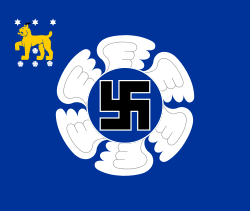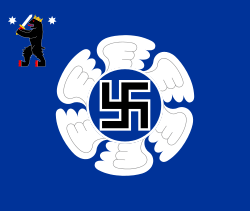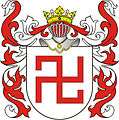Western use of the swastika in the early 20th century
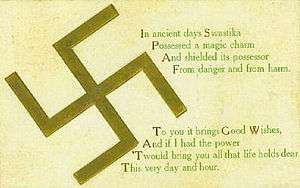
The swastika (from Sanskrit svástika) is a symbol that generally takes the form of an equilateral cross, with its four arms bent at 90 degrees in either right-facing (卐) form or its mirrored left-facing (卍) form. Archaeological evidence of swastika-shaped ornaments dates from the Neolithic period and was first found in the Mezine, Ukraine. It is considered to be a sacred and auspicious symbol in Hinduism, Buddhism and Jainism religions.
The swastika (gammadion, "fylfot") symbol became a popular symbol of luck in the Western world in the early 20th century, as it had long been in Asia, and was often used for ornamentation. The Nazi Party adopted the symbol in the 1920s, and its use in Western countries faded after the Nazi association became dominant in the 1930s.[1] In recent decades many public swastikas have been removed or covered over, although others have been deliberately retained as part of debate about historical preservation.
Background
.jpg)
The discovery of the Indo-European language group in the 1790s led to a great effort by archaeologists to link the pre-history of European people to the ancient "Aryans" (variously referring to the Indo-Iranians or the Proto-Indo-Europeans). Following his discovery of objects bearing the swastika square in the ruins of Troy, Heinrich Schliemann consulted two leading Sanskrit scholars of the day, Emile Burnouf and Max Müller. Schliemann concluded that the Swastika square was a specifically Indo-European symbol, and associated it with the ancient migrations of Proto-Indo-Europeans. He connected it with similar shapes found on ancient pots in Germany, and theorised that the swastika square was a "significant religious symbol of our remote ancestors", linking Germanic, Greek and Indo-Iranian cultures.[2][3] Later discoveries of the motif among the remains of the Hittites and of ancient Iran seemed to confirm this theory, but the symbol was also known for its use by indigenous American Indians as well as Eastern cultures.
By the early 20th century it was used worldwide and was regarded as a symbol of good luck. The swastika's world-wide use was well documented in an 1894 publication by the Smithsonian.[4] The symbol appeared in many popular, non-political Western designs from the 1880s to the 1920s, with occasional use continuing into the 1930s.
Western use of the motif was subverted in the early 20th century after it was adopted as the emblem of the Nazi Party (German: Nationalsozialistische Deutsche Arbeiterpartei). The swastika was used as a conveniently geometrical and eye-catching symbol to emphasise the so-called Aryan-German correspondence and instill racial pride. Since World War II, most Westerners have known the swastika as a Nazi symbol, leading to confusion about its sacred religious and historical status.
By country
Argentina
Several columns at the train station of Retiro in Buenos Aires are decorated with joint swastikas. The Estación Retiro opened in 1915.
Australia
Sydney has two notable buildings using the swastika as an architectural element. The 1920s-era Dymocks Building in George Street, Sydney includes a multi-level shopping arcade, the tiled floors of which incorporate numerous left-facing swastikas. A brass explanatory sign, probably dating to World War II, is affixed to the wall near the elevator doors on each floor of the building, and refers to it as a "fylfot", emphasising that its use in the building pre-dates any Nazi connotations or usage.[5] In nearby Circular Quay, the Customs House also has fylfot tiles in the front entrance area dating from the same period, with a plaque to explain the symbols.[6]
Britain

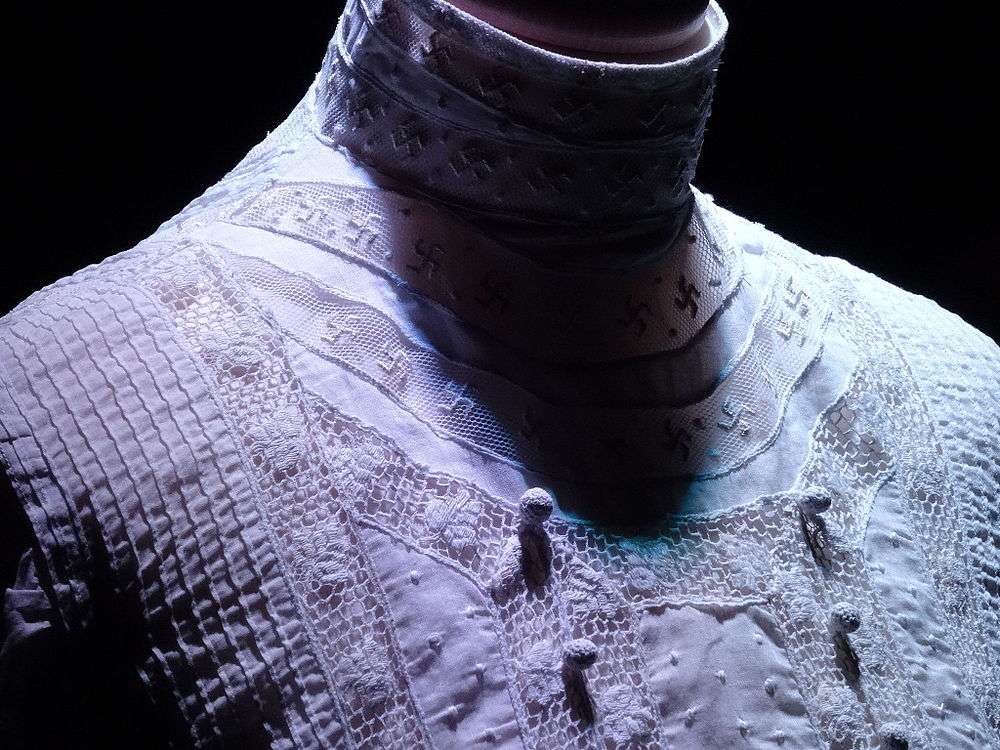
The Anglo-Indian author Rudyard Kipling (1865–1936), who was strongly influenced by Indian culture, used a swastika as his personal emblem on the covers and flyleaves of many editions of his books, along with the elephant, signifying his affinity with India. With the rise of Nazism, Kipling ceased to use the swastika. One of his Just So Stories, "The Crab That Played With The Sea", included an elaborate full-page illustration by Kipling including a stone bearing what was called "a magic mark" (a swastika); some later editions of the stories blotted out the mark on the stone, but left the caption unaltered, leaving readers puzzled.

During the First World War, the swastika was used as the emblem of the British National War Savings Committee.[7]
The swastika was also used as a symbol by the Boy Scouts in the Britain, and worldwide. According to "Johnny" Walker, the earliest Scouting use was on the first Thanks Badge introduced in 1911.[8] Robert Baden-Powell's 1922 Medal of Merit design added a swastika to the Scouting fleur-de-lis as a token of good luck for the person receiving the medal. Like Kipling, Baden-Powell would have come across this symbol in India. During 1934 many Scouters requested a change of design because of the use of the swastika by the Nazis. A new British Medal of Merit was issued in 1935.
A bank in Bolton has refused to remove swastika mosaic tiles from the entry of a branch office constructed in 1927. A bank spokesperson replied to critics noting that "At that time, these symbols were commonly used as architectural decoration."[9]
Located on the Woodhouse Crag, on the northern edge of Ilkley Moor in West Yorkshire there is a swastika-shaped pattern engraved in a stone, known as the Swastika Stone. The figure in the foreground of the picture is a 20th-century replica; the original carving can be seen a little further away, at the centre-left of the picture.[10]
There are both left- and right-facing swastikas on the war memorial at the entrance to Balmoral Castle in Scotland.[11]
The druids in the mid-1920s adorned their dress with swastikas.[12][13]
There is a Fylfot made into the brickwork on a building inside the British Aerospace factory in Broughton in Wales. It is unknown why the Fylfot was put on a brick but it has been suggested it was done so because it was an ancient Asian peace symbol. The current Broughton site which makes wings for the Airbus has a history of fighter plane construction going back to WWI.
The Royal Air Force's 273 Squadron adopted a cruciform fylfot as opposed to the Nazi Swastika which was a reversed fylfot, which it used as a squadron badge. It was around since the earliest RAF in 1918 and was an emblem for the Ceylon Fighter Defence in 1939.[14][15]
The Essex County Council headquarters in Chelmsford features engraved swastika facing both left and right. Constructed beginning in 1928, the building was finished in 1939, the same year Britain declared war on Nazi Germany. The architectural design had been finalized years before. [16]
Many churches and cathedrals in the UK feature swastika motifs.[17][18]
Canada
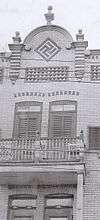
Swastika is the name of a small residential community in northern Ontario, Canada, approximately 580 kilometres north of Toronto, and 5 kilometres west of Kirkland Lake, the town of which it is now part. The town of Swastika was founded in 1906. Gold was discovered nearby and the Swastika Mining Company was formed in 1908. The government of Ontario attempted to change the town's name during World War II, but the town resisted and many posted signs "The hell with Hitler. We came up with our name first!". The Swastika United Church is located in Swastika, Ontario, as is the Swastika Public School, Swastika Fire Hall and Swastika Laboratories, which provides assaying services for the mining industry.[19]
In Windsor, Nova Scotia, there was the Windsor Swastikas ice hockey team from 1905 to 1916, and their uniforms featured swastika symbols. There were also hockey teams named the Swastikas in Edmonton, Alberta (circa 1916), and the Fernie Swastikas in Fernie, British Columbia (circa 1922).
The Traveller's Hotel in downtown Ladysmith, British Columbia, has a façade decorated with brickwork swastikas. Further north on Vancouver Island, the Japanese cemetery in Cumberland has several grave markers decorated with swastikas.
A repeating pattern of swastikas appeared on a few Canadian postage stamps that were produced by commercial airlines from 1924–32.[20]
There used to be a swastika brick pattern located outside at the top of a house located at 75–81 Troy Street, in Verdun, a borough of Montreal, Quebec. A picture of this house appears on page 138 of Hélène-Andrée Bizier's Une Histoire du Québec en photos (2006, Éditions Fides).
The swastika was also used as border art for the weekly pet health column in the Calgary Herald newspaper in the early years of the 20th century.[21]
Denmark
The Danish brewery company Carlsberg Group used the swastika as a logo[22] from the 19th century until the middle of the 1930s, when it was discontinued because of association with the Nazi Party in neighbouring Germany. However, the swastika carved on elephants at the entrance gates of the company's headquarters in Copenhagen in 1901 can still be seen today.[23]
Finland

.svg.png)

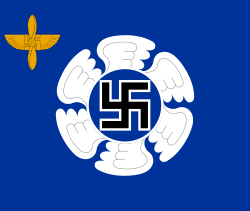

In Finland the hakaristi (swastika) was used as the official national marking of the Finnish Defence Forces between 1918 and 1945 and also of the Finnish Air Force, anti-aircraft troops as a part of the air force and tank troops at that time. The swastika was also used by the Lotta Svärd organisation, Finnish paramilitary organisation for women, which was dissolved in 1944 according to the terms of the Moscow Armistice.
Finnish heraldry does not distinguish between swastika and fylfot; they both are called hakaristi ("hook-cross"). Most hakaristi devices are actually fylfots.
The Finnish Airforce units still wear a swastika on their colours.[24][25] In addition, the shoulder insignia of the Airforce Headquarters bears a swastika design.[26] In 1945 the Air Force changed its national emblem to a roundel but the use of swastika in some other insignia was continued. In 1958, the President of Finland Urho Kekkonen inaugurated the colours of the Air Force units which feature a swastika design. The latest colour of this pattern was inaugurated by president Tarja Halonen 25 October 2005 for the newly formed Air Force Academy.[26] Also the Utti Jaeger Regiment, responsible for training special forces, bears a swastika-like emblem (sun cross) on its colour.
The swastika has not disappeared in Finnish medals and decorations. The decorations of the Order of the Cross of Liberty, designed by Akseli Gallen-Kallela – who also designed the emblem of the Finnish Air Force and the Finnish flight mark in 1918 – bears a fylfot laid on a George's Cross. The President of Finland uses a Cross of Liberty in the personal flag. However, in the flag is only the Cross of Liberty of 3rd Class and overall, the highest Finnish decoration is the Grand Cross of the White Rose with Collar.
Germany

Swastika saw use by nationalist movements before Nazis emerged into prominence: the Bundesarchiv has photos from the 1920 Kapp Putsch showing Marinebrigade Ehrhardt Freikorp using the symbol.
Iceland
Eimskipafélag Íslands (founded in 1914), a major shipping company in Iceland, once used a variation on the swastika as their company logo. The appearance was similar to a blue fylfot on a white circle. Usage continued after World War II – MV Gullfoss in service from 1950 to 1972 had the symbol in a roundel on the ship's prow. Although they have since replaced their logo, the swastika remained on their old headquarters, located in downtown Reykjavík. When the Radisson SAS hotel franchise bought the building, the company was banned from destroying the symbol since the building was on the list of historical sites in Iceland. A compromise was made when the company was allowed to cover the symbol with the numbers 1919 which was the year when the building was erected.[27]
Ireland
In Dublin, Ireland, a laundry company known as the Swastika Laundry existed for many years in Dartry and Ballsbridge (both on the river Dodder) on the south side of the city. It was founded in 1888 as the Dublin Laundry Company.[28] Upon the outbreak of World War II in 1939, the company's customers were concerned about the company's name. Accordingly, it was changed to "Swastika Laundry (1912) Ltd". The company's fleet of electric delivery vans were red, and featured a black swastika on a white background.[28]
The business started in the early 20th century and continued up until recent times. The Laundry's tall chimneystack was emblazoned with a large white Swastika, a protected structure,[29] which was clearly visible from the surrounding streets. The name and logo eventually disappeared when the laundry was absorbed into the Spring Grove company.
In his "Irisches Tagebuch" the future Nobel Laureate, Heinrich Böll writes about a year spent living in the west of Ireland in the 1950s. While in Dublin before heading to Co. Mayo, he…
"was almost run over by a bright-red panel truck whose sole decoration was a big swastika. Had someone sold Völkischer Beobachter delivery trucks here, or did the Völkischer Beobachter still have a branch office here? This one looked exactly like those I remembered; but the driver crossed himself as he smilingly signalled to me to proceed, and on closer inspection I saw what had happened. It was simply the "Swastika Laundry", which had painted the year of its founding, 1912, clearly beneath the swastika; but the mere possibility that it might have been one of those others was enough to take my breath away."[30]
Latvia
In Latvia, too, the swastika (known as Fire Cross, Latvian: ugunskrusts, or Thunder Cross, Latvian: pērkonkrusts) was used as the marking of the Latvian Air Force between 1918 and 1934, as well as in insignias of some military units.[31] It was also used as a symbol by the Latvian fascist movement Pērkonkrusts, as well as by other organisations.
Latvian left-facing swastika or Thunder Cross dates back to Bronze Age. It is widely seen scratched on the surfaces like rocks, weapons and pottery as a protector sign. To avoid diplomatic embarrassment, Latvian officials were asked by NATO not to put swastikas on mittens and other gifts to delegates at a summit in the country in 2006.[32]
Norway
The iron balconies of the building facing Veiten in Bergen are also decorated with swastikas. One may think they date back from the war, as they face the old Gestapo headquarters in Bergen, but they are actually twenty years older.[33]
Poland

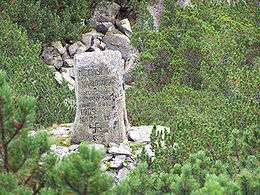
Since the early Middle Ages the sign of the swastika was well established among all Slavic lands. Known as swarzyca, it was primarily associated with one of the Slavic gods named Svarog.
With time the association with Slavic gods faded, but the swastika was preserved both as a personal symbol of various personalities, such as the Boreyko Coat of Arms, and in folk culture, for example, in the region of Podhale, where the swastika was used as a talisman well into the 20th century. As a solar symbol, it was painted or carved on various parts of houses in the Tatra Mountains and was thought to save the household from evil.
The ancient symbol used by the Góral societies was adopted by the Polish mountain infantry units in the 1920s. It was adopted as a regimental insignia by the artillery units of the 21st and 22nd Infantry Divisions, as well as by the soldiers of the 4th Legions' Infantry, the 2nd and the 4th Podhale Rifles. A distinctive blue swastika was a background emblem of the Air defence and Anti-gas League (1928–1939, LOPP), which had circa 1.5 million members in 1937.
Outside of the military traditions, the mountaineer's swastika also influenced a number of other symbols and logos used on Polish soil. Among such was the logo of the IGNIS publishing company (est. 1822), and the personal symbol of Mieczysław Karłowicz, a notable composer and admirer of the Tatras. After his death in the mountains in 1909, the place of his death was marked by a memorial stone and a swastika.[34]
Russia
The Russian Provisional Government of 1917 printed a number of new bank notes with right-facing, diagonally rotated swastikas in their centres.[35]
Sweden
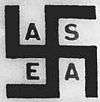
In a painting of the Norse god Thor fighting jǫtnar, by the Swedish artist Mårten Eskil Winge from 1872, a swastika is clearly visible in his belt.
The Swedish company ASEA, now a part of Asea Brown Boveri, used the swastika in its logo from the 1890s to 1933, when it was removed from the logo.
United States
As a Native American symbol
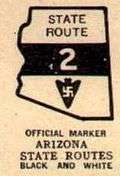
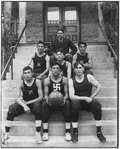
Because this was a popular symbol with the Navajo people, the Arizona Department of Transportation marked its state highways with signs featuring a right-facing swastika superimposed on an arrowhead.[36] In 1942, after the United States entered World War Two, the department replaced the signs.
The original Penobscot Building in Detroit, Michigan, completed about 1906, "was named after the Penobscot Indian tribe and region of Maine, the boyhood home of one of the investors. An interesting feature in the Indian-themed detail of the building is the occasional appearance of a swastika, a symbol important to the Penobscots long before it was adopted by the Nazi party."[37] The decorative symbols feature right-facing arms and are tilted in the same manner as the Nazi flag, leading to confusion over their origin.
Use by the military
.svg.png)
The 45th Infantry Division of the United States Army used a yellow swastika on a red background as a unit symbol until the 1930s, when it was switched to a thunderbird.[38][39][40] The American Division wore the swastika patch while fighting against Germany in World War I.
The Lafayette Escadrille squadron flew World War I fighters against Germany from 1916 to 1918, first as volunteers under French command and later as a United States unit.[41] The official squadron insignia was a Native American with a swastika adorned headdress. Some of the squadron planes also bore a large swastika in addition to the squadron insignia.[42]
Among the Lafayette Escadrille members who were killed in action was Arthur Bluethenthal of Wilmington, North Carolina, who is buried in a Jewish cemetery with a grave marker that includes the squadron insignia, complete with swastika.[43]
The U.S. Army 12th Infantry Regiment coat of arms includes a number of historic symbols. A tepee with small, left facing swastikas represents the unit's campaigns in the Indian Wars of the late 19th century. The Regiment fought German forces during World War II, landing on D-Day at Utah Beach, through five European campaigns and received a Presidential Unit Citation for action during the Battle of the Bulge.
Government use
Swastikas surround the exterior window iconography at the Marriner S. Eccles Federal Reserve Board Building in Washington D.C. on Constitution Avenue between 20th and 21st Streets. The building was designed by Paul Philippe Cret and completed in 1937. Cret fought against Germany during World War I while serving in the French army.
The Reno, Nevada Post Office features both left and right facing swastikas, along with other designs typical of "Zig Zag Moderne" style, later known as a variation of "Art Deco". It was designed in 1932 by Frederic Joseph DeLongchamps, who had previously served as the Nevada State Architect.[44] The building was financed in part by the federal Civil Works Administration and was listed on the National Register of Historic Places in 1990.
The Allentown, Pennsylvania Post Office, built in 1934, included inlaid swastika floor tiles. In 1965 The General Services Administration removed tiles with arms facing to the right, but retained some with arms facing to the left.[45]
The six-story Federal Building in downtown Albuquerque, New Mexico features a Mediterranean style and decorative Native American design motifs. Built in 1930, its decorative features include "Radiators set in each wall of the foyer [that] are hidden by brass grilles in a swastika design".[46] It has been listed on the National Register of Historic Places since 1980.[47]
The third La Crosse County, Wisconsin courthouse was built in 1903 and razed in 1965. Numerous swastika patterns are visible in photographs of a mosaic tile floor. The symbols have shortened arms pointing to the left.[48]
The DeKalb County Courthouse in Sycamore, Illinois, built in 1905, includes swastika decorated railings. The Classical Revival style courthouse was added to the National Register of Historic Places in 1978.
Swastikas are a minor feature in painted murals in the Allen County Courthouse in Fort Wayne, Indiana, completed in 1902. They are described as "a Native American symbol for joy".[49] The murals were restored beginning in 1994 as part of an eight-year, $8.6 million project. The courthouse was listed on the National Register of Historic Places in 1976, and as a National Historic Landmark in 2003.[50]
Mosaic swastika tile patterns decorate the floor of the Washington County Courthouse in Marietta, Ohio, designed by Cincinnati architect Samuel Hannaford and built in 1901. The tiles are described as "an adopted Indian symbol for 'good luck and prosperity.'"[51]
The Laguna Bridge[52] in Yuma, Arizona was built in 1905 by the U.S. Reclamation Department and is decorated with a row of swastikas with right-facing arms.[53][54]
Displayed with Christian and Jewish symbols
Several examples of U.S. architectural decoration feature swastikas displayed alongside other religious symbols.
The Bahá'í House of Worship for the North American continent, located in Wilmette, Illinois, depicts religious symbols on each of its 9 outer pillars. "The symbols are arranged in chronological order-from bottom to top-on the pillars. That's why the swastika is at the base, with the Star of David above it..."[55] The design dates to 1920 but construction was not completed until 1953. The largest Bahá'í House of Worship in the world, the white domed building has been listed on the National Register of Historic Places since 1978.
The "Golden Rule Window" in the Transfiguration Episcopal Church in New York City features medallion symbols depicting world religions, with Buddhism represented by the "flyflot cross" near a Jewish menorah. Built in 1849 with several modifications through 1926, the church was listed on the National Register of Historic Places in 1973. During the Civil War the church worked for abolition of slavery and harboured runaway slaves.[56]
A student union at the University of Michigan includes a 1929 chapel with stained glass windows that feature religious symbols. A swastika with right-facing arms is included, along with a Christian cross, Hebrew star and others.[57]
The Yerkes Observatory in Lake Geneva, Wisconsin, established in 1897 by the University of Chicago, includes ornate decoration. The rotunda includes a swastika symbol adjacent to a Star of David.[58]
Placenames
Swastika Park is the name of a housing subdivision in Miami, Florida, created in 1917.[59]
An upscale subdivision in Denver is named "Swastika Acres". Its name has been traced to the Denver Swastika Land Company, founded in 1908.[60]
Swastika, New York, located near the Adirondack Park Preserve in the northeast corner of the state, is adjacent to "Swastika Road".
The "Swastika Trail" is a historic auto trail in Iowa.[61]
Commercial use
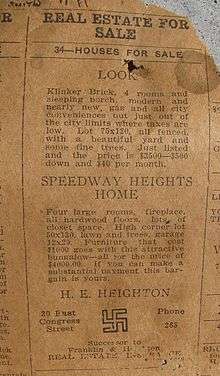
The K-R-I-T Motor Car Company, Detroit, Michigan built cars from 1909 to 1915 with a radiator badge that featured a right-facing white swastika on a blue background.[62]
The Crane Valve Company manufactured steel valves in the 1920s and 30's in the U.S. with swastika markings, using a symbol with the arms pointed to the right.[63]
The Buffum Tool Company of Louisiana, Missouri manufactured "High Grade Tools for High Grade Workmen" from about 1909 to 1922. The Buffum company's trademark was a swastika with right facing arms. During World War I it made bayonets and aeroplane parts. The company's logo was the "Good Luck/Blessing/Swastika Cross" and many of the products, sold nationwide, had "the good luck cross on them."[64][65]
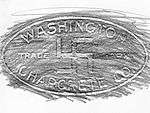
The Washington Charcrete Company manufactured "laundry trays" (concrete utility sinks) with an imprinted logo bearing a swastika. Some examples survive (see pictures[66][67]), but the date of their manufacture is unknown. The company did business in the states of Washington and Oregon and is mentioned in a 1914 ruling by the Supreme Court of Washington State.[68]
The Duplex Adding Machine Company of St. Louis, Missouri issued stock certificates in 1910 that show the company's logo, a swastika with right-facing arms and math symbols.[69]
Flour was sold under the brand name Swastika, The Lucky Flour by the Federal Milling Co., Lockport, N.Y. as advertised in 1909,[70] and by the Monte Vista Milling and Elevator Company of Colorado, which registered the name in 1910.[71]
The Downtown Historic District in Raton, New Mexico, listed on the National Register of Historic Places, includes the Swastika Coal office and Swastika Hotel buildings.
The mining town of Lakeview Idaho featured a "Swastika Hotel" in 1910, owned and operated by the Swastika Mining Company.[72]
The St. Louis, Rocky Mountain and Pacific Railroad Company operated with cars and locomotives "emblazoned with the red swastika symbol adopted as the road’s trademark." The symbol featured right facing arms and was tilted at an angle. The 105-mile "Swastika Line" operated from about 1902 to 1915, with major stops at Raton and Cimarron, New Mexico. The tracks were torn up for scrap during World War II when "Swastika Line iron was used to fight a different kind of swastikas in Europe."[73]
A "Swastika Theater" operated in Sausalito, California in the early 20th century.[74] Another "Swastika Theater" operated in Akron, Indiana.[75]
The Swastika Novelty Company of Charleston, W.Va., made a "talking board", similar to a Ouija board, in 1907.[76]
"Swastika Boards" were built using laminated redwood and balsa wood by legendary surfer Lorrin "Whitey" Harrison in Los Angeles from 1931 until 1939 when they were renamed "Waikiki Surfboards"[77] "Swastikas became the most widely used production solid board of the period leading into World War II."[78]
In popular culture
The swastika is seen on binders of pre-Nazi era publications of works by Rudyard Kipling. Both left and right orientations were used.
Two white swastika symbols on an Indian blanket made an appearance in the 1922 Buster Keaton silent movie "The Paleface". A newspaper columnist noted Nazis had adopted the swastika in 1920, prior to the film's release but that "Only a bonehead would read anything sinister into that coincidence."[79]
Publisher Harold Hersey adopted a blue swastika as a symbol for his line of pulp magazines, Magazine Publishers. When the company was purchased by A. A. Wyn in 1929, the swastika was replaced with an Ace of Spades.[80]
Swastika quilt patterns were popular in America prior to World War II.[81] In 2010 the Greeley Museums in Greeley, Colorado received a donated quilt covered in 27 swastikas, believed to date to around 1900. "The swastika quilt-block pattern is also known as the Battle X of Thor, Catch Me If You Can, Devil's Dark Horse, Whirligig and Zig Zag" according to the museum registrar. The quilt was not put on general display while museum officials considered how to provide context.[82]
A quilt with swastika-like pattern dating to 1927 was removed from display from a Havre, Montana museum in December 2010 after complaints from the public. A group of residents of the Bear's Paw Mountains had embroidered their names in the historic quilt, a gift for an ill neighbor. "It was a very, very nice quilt and the story behind it was absolutely heartwarming" according to a member of the museum foundation.[83]
Metal typeface Swastika borders were used by U.S. printers in the early 20th century.[84] Controversy arose in 1937 when they appeared on Passaic, New Jersey sample election ballots. The printer responded, "I've used the swastika emblems for ballot borders long before the world ever knew Hitler."[85]
In the novel The Great Gatsby, the story of which takes place during the Roaring Twenties, one of the characters runs a business called "The Swastika Holding Company."
Use by non-political clubs and organisations
The Ladies' Home Journal sponsored a Girl's Club with swastika membership pins, swastika-decorated handkerchief and a magazine titled "The Swastika". Their version of the symbol was square with right facing arms. The club was formed at the beginning of the 20th century to encourage young women to sell magazine subscriptions.[86]
The 1939 Tennessee State University yearbook lists a "Swastika Club" among women's student organisations. The group focused on literature, scholarship and "clear and straight thinking". Tennessee State is the only state-funded historically Black university in Tennessee.[87]
The yearbook for Catawba College in Salisbury, North Carolina, first published in 1927, was known as the "Swastika", after a Native American design pattern found in the original tile of a campus administration building. The name was changed in 1941.[88] The liberal arts college was established by the United Church of Christ in 1851.
The Boston Braves professional baseball team wore a "luck inviting Swastika emblem" on the front of their caps on opening day in 1914.[89]
At least one minor league baseball team used the name: the Cañon City Swastikas represented Cañon City, Colorado in the Class D Rocky Mountain League in 1912. The team moved to Raton, New Mexico mid-season, then disbanded along with the league.
The "Swastika Club of Freedom Township" was formed in 1923 in rural Iowa, a social club serving farm women. The group produced a "Swastika Club Cookbook" in 1934. Its name was changed to the "Freedom Township Women’s Club" in 1942.[90] Another "Swastika Club" for women met in Howell County Missouri in the 1920s.[91]
The Swastika Canoe Club, of Pawtuxet Village competed with other canoe clubs in the eastern U.S.[92][93]
Coins, tokens and watch fobs
Collectors have identified more than 1,400 different swastika design coins, souvenir or merchant/trade tokens and watch fobs, distributed by mostly local retail and service businesses in the United States. The tokens that can be dated range from 1885 to 1939, with a few later exceptions. About 57 percent have the swastika symbol facing to the left, 43 percent to the right. Most promise good luck or feature other symbols such as a horseshoe, four leaf clover, rabbit's foot, wishbone or keys.[94]
In 1925, Coca-Cola made a lucky watch fob in the shape of a swastika with right-facing arms and the slogan, "Drink Coca Cola five cents in bottles". The Waterloo Gasoline Engine Company of Waterloo, Iowa offered a "Good Luck" token featuring a left facing swastika in addition to a four-leaf clover, horseshoe, wishbone and Plains Indian emblem. The company was sold in 1918 and became known as the John Deere Tractor Company.[95] Harvard University Library has a 1908 leather watch fob with a brass swastika that was created for the presidential campaign of William Jennings Bryan.[96]
The 1917 World War I good luck medal was produced in the United States with an American eagle superimposed by a four-leaf clover "and a swastika – an ancient symbol of good luck".[97] The medal was designed by Adam Pietz, who served as Assistant Engraver at the United States Mint in Philadelphia for nearly 20 years.[98]
Some Boy Scout good luck tokens issued by the Excelsior Shoe company feature the swastika on the reverse.[99]
Architectural use
The Cliff Dwellers Apartment building in New York City, completed in 1914, features two terracotta swastikas, tilted with arms pointing to the left. The building is well known for its western themed frieze, featuring buffalo skulls, mountain lions and rattlesnakes.[100]
The Garfield Monument in Cleveland Ohio, dedicated in 1890 as a tomb and memorial for assassinated U.S. President James A. Garfield, contains swastika tile patterns throughout the floor.[101][102] The 180-foot-tall (55 m) building was added to the National Register of Historic Places in 1973.[103]
A small swastika is visible in the elaborate carvings representing several cultures above the main entrance to the Yale University Library.[104]
A Chicago television investigative journalism report in July 2015 found numerous examples of swastikas in the city's architecture. "A swastika is on the front of Chicago's most popular tourist attraction, Navy Pier, and seen at the one of Columbia College's South Loop buildings. It is embedded in marble floors at University of Chicago on the Lower West Side and an embellishment on a city monument to Jacques Marquette. The design is on what is now the Bridgeview Bank, and the former Continental Illinois Bank, along with countless pre-WWII Chicago homes and apartment buildings."[105]
Swastikas are featured in the entryway of the Montana Club in Helena, Montana.[106] Rebuilt in 1905 using a design by architect Cass Gilbert, the site is the "oldest social club in the northwest" and in a historic district listed on the National Register of Historic Places.[107]
The KiMo Theatre in Albuquerque, New Mexico, built in 1927 in the Pueblo Deco style and restored in 2000, is owned and operated by the city, which describes it as an "architectural gem". The building includes Native American design elements, including swastikas with right facing arms.[108] It was nearly torn down in 1977, the same year the KiMo was listed on the National Register of Historic Places.
In 1907, the Corn Palace in Mitchell, South Dakota, featured a design that had a swastika on one of the towers as an "Indian good luck sign".[109] Each year the exterior is covered with elaborate murals made of South Dakota corn, grain and grasses. The building is the centerpiece of a historic district that is listed on the National Register of Historic Places.
In Rapid City, South Dakota, there are swastikas in the lobby of the Hotel Alex Johnson, which opened in 1928. They are decorations honoring the Native American culture of Western South Dakota. The hotel is listed on the National Register of Historic Places.
At the University of Maine, in Orono, Maine, three dormitories resemble swastikas when viewed from satellite images. UMAINE map
The Weston building on the campus of Williams College in Massachusetts features left facing, tilted swastika brick patterns. The building was originally a fraternity with a charter that banned Jews and non-Caucasians. The college uses it for language classes to ensure regular use by different cultures, and built a Jewish religious center behind it.[110]
The Shaffer Hotel in Mountainair, New Mexico features both right and left facing swastika designs among its many Native American graphics.[111] It has been listed on the National Register of Historic Places since 1978. As of 2016, it is closed.
The Perelman Building[112] was completed in 1928 as the headquarters of the Fidelity Mutual Life Insurance Company but is now part of the Philadelphia Museum of Art. Swastikas are visible in the elaborate decorative scheme, credited to Lee Lawrie.[113] The building was listed on the National Register of Historic Places in 1973.
The Entrance to the Philadelphia Museum of Art features a walkway frieze with a swastika meander pattern. The first section of the current building was completed in 1928.[114]
A Philadelphia fire station built in 1927 became controversial when local residents petitioned to remove a swastika design resembling the German Military Iron Cross. The township Commissioners, a majority of whom are Jewish, voted in 1998 to deny the petition, a position supported by local representatives of the Anti-Defamation League and Jewish Community Relations Council. "A symbols meaning, they say is tied to its context" [115]
The Augustan Society Headquarters and Library, built in 1916 in the Mojave Desert in Daggett, California, includes Native American swastika designs.[116] The non-profit is "An International Genealogical, Historical Heraldic and Chivalric Society".
The 1926 Pueblo Revival—Spanish Colonial Revival—Mission Revival Style architecture of the Orcutt residence is decorated with Native American swastikas. It is located at the Orcutt Ranch Horticulture Center in West Hills, Los Angeles, California. The property has been designated a Los Angeles Historic-Cultural Monument.
Both right and left facing swastikas appear in disks near the top of columns on the Alexander & Baldwin building in Honolulu, Hawaii, built in 1929 and added to the National Register of Historic Places in 1979.[117]
Sidewalks with swastika impressions can be found at Indian Village, Detroit, a historic neighborhood on the city's east side. The concrete impressions, dated 1914, bear the word "Quality" and the name of the construction company. [118]
A swastika design is visible on the exterior of the Detroit, Michigan downtown public library, built in 1931. A local website notes "They were a popular item in certain Deco designs, and many are used in architecture throughout Downtown Detroit. They also can be seen quite often on floor tiles in church buildings."
The First Chinese Church of Christ in Honolulu, Hawaii, dedicated in 1929, features wooden pews with swastika carvings. The church website says they "depict the wan-zi, an ancient Chinese symbol of 10,000 years of eternal blessedness. Sadly, Hitler reversed this symbol and made it into his Nazi swastika."[119]
The Carlton Apartments in Houston, Texas, built in 1918, features an entryway framed by tiles with various patterns including the swastika.[120]
Efforts to remove historical swastikas
More than 900 cast iron lampposts decorated with swastikas remain in place in downtown Glendale, California. The lampposts were manufactured in Canton, Ohio and installed in the 1920s. In 1995 the city responded to complaints that the lampposts should be removed. The city attorney's response included "...research has revealed that the symbol itself was not uncommon in Judaism. The symbol itself has been found to appear in ancient synagogues as well as being found as a symbol appearing on sarcophagus in Roman catacombs."[121] Cost to replace the lampposts was estimated at $3 million.[122] The Glendale Historical Society "has recommended preservation of the lampposts to the maximum extent possible."
Similar swastika designs can be seen on the lampposts outside the old San Francisco Mint, built in 1873, and listed on the National Register of Historic Places since 1976 and currently serves as a museum.[123]
The California State Historical Resources Commission nominated the Los Gatos Union High School for listing on the National Register of Historic Places in 2003. Historic Architect A. G. Dill thanked the commission. "Ms. Dill stated that her office was galvanised in 1999 when the new school principal attempted to chisel off the Greek key design because it had a swastika pattern. The school was built in 1925 prior to the Nazi’s taking over the symbol. Educators need to be educated."[124]
The New Mexico State University yearbook continued under the name "The Swastika" in honour of the traditional meaning of the symbol.
In January 1999, Civil Rights groups asked the Jefferson County, Alabama Commission to remove nine swastikas carved into stone pillars at the county courthouse in Birmingham, Alabama. The building was completed in 1931 with symbols featuring both left and right facing arms. A commission aide said officials would not consider the request unless there were "an awful lot of folks worrying us."[125]
The restored Balboa Park Hospitality House in San Diego became controversial when swastika symbols were discovered on five light fixtures. The design dates to 1935. Park officials welded metal plates over the swastikas after a protest by the Anti-Defamation League.[126] The San Diego Historical Society notes that the lamps were donated by a German American group and were intended to represent Nazi symbols.[127] The nearby Balboa Park tea house had previously featured swastika decorations in 1915.[128]
A hand-carved wooden horse with swastikas on its saddle[129] has been removed from a classic carousel at a shopping center in Portland, Oregon following complaints by the public. The carousel was built in 1921 and installed in Venice, California and later was a featured ride at Jantzen Beach Amusement Park which opened in 1928 as the largest amusement park in the United States.[130] The Parker "Four-Row Park Carousel" was added to the National Register of Historic Places in 1987. It is the only surviving carousel out of four made from the design. The original was created for the 1904 St. Louis World's Fair.
Swastika tiles
Ceramic tiles with a swastika design were produced by a number of North American manufacturers in the late 19th and early 20th centuries. They were often installed in repeating patterns or in combination with related ancient symbols. In western architecture, pre-World War II swastika tiles are typically a minor decorative element and have only become prominent when their original intent or symbolic meaning has been re-interpreted.
Swastika tiles adorn the New Jersey Statehouse in Trenton, in a room built in the 1930s. A newspaper article in The Press of Atlantic City notes that the statehouse tiles were created by the local Mueller Mosaic Company.[131] Led by Herman Carl Mueller, the firm used an innovative technique that combined glazing and deep carving to create a photographic-like sense of depth. The tiles were installed throughout the United States and Canada. The swastika design was only one of many different symbols featured in the Mueller catalogue.
A Detroit columnist in 2015 began a campaign to remove swastika tiles from the Detroit Athletic Club, designed by Jewish architect Albert Kahn in 1915. [132]
Reprints of tile catalogues, including the 1930 Mueller Mosaic Faience Tile Inserts catalogue are available from the non-profit California based Tile Heritage Foundation. Swastika tiles are also featured in the 1920 catalogue from Wheatley Pottery Company of Cincinnati Ohio, the 1928 catalogue from the Cambridge-Wheatley Company of Covington, Kentucky, which marketed Wheatley tiles and a 1930s catalogue from the Franklin Pottery Company of Lansdale, Pennsylvania.
The Mueller tiles with swastika design can be found at the St. James Episcopal Church (1927), and the Immanuel Presbyterian Church (1928) in Los Angeles.[133]
In May 2006, five terra cotta tiles were removed from St. Mary's Cathedral in St. Cloud Minnesota, the oldest parish in the community.[134] The upper church, constructed in the late 1920s, included a number of decorative tiles including a series of ten that depicted ancient forms of the cross.[135] Located near the eaves, the tiles represented the crux gammata, also known as the Gammadion, "hooked cross". The five swastika tiles alternated with a related design featuring the Lauburu or "Basque cross".[136] The upper church's final design was created by the local architectural firm of Nairne W. Fisher, who had fought against Germany during World War I.[137] Three of the tiles were destroyed in the process of removal, one was put on permanent display at the church. The removal was prompted in part by criticism from some current and former faculty at St. Cloud State University, where the university's electronic diversity newsletter featured a series of articles, including a history of the swastika that claimed by 1920 it was already "the symbol of Aryan conquest and mastery".[138]
Other Catholic Cathedrals that include swastika tiles among their decorations include: Saint Joseph Cathedral, Wheeling, West Virginia, a Romanesque design by architect Edward J. Weber of Pittsburgh, completed in 1925. St. Colman's Cathedral, built between 1868 and 1925 overlooking the port city of Cobh Ireland. Christ Church Cathedral, New Zealand, constructed in the 1880s. The Cathedral of Tampico, Tamaulipas, completed in the late 19th century with additional remodelling (see Tour By Mexico website for photograph of swastika tile floor, click on fifth camera icon). A tile floor at Hereford Cathedral in England is laid out in a swastika like pattern with arms pointed to the right.[139] The floor at Amiens Cathedral in France features a right-facing swastika pattern with shortened arms, similar to the St. Cloud tiles. A popular tourist destination, Amiens is protected as a UNESCO World Heritage site.
The Plummer House in Rochester, Minnesota includes swastika tiles. The five-story home was constructed beginning in 1917 by Dr. Henry Plummer, a prominent figure in the history of the Mayo Clinic.[140] The home was designed by Thomas Ellerbe, a second generation architect whose firm is now known as Ellerbe Becket.[141] It has been listed on the National Register of Historic Places since 1975.[142]
In 2008, school officials decided not to remove swastika floor tiles with left-facing arms from a Duluth, Minnesota elementary school built in 1929. A member of the City's Native American Commission noted that the nine tiles at the school entrances have roots in Native American symbolism. "It has absolutely nothing to do with the Nazi symbolism."[143]
St. Columba's Catholic Church in Johnstown, Pennsylvania, was designed by Pittsburg architect John T. Cornes and completed in 1914 as a territorial church for English speaking immigrants.[144] Various forms of the cross are represented in the sanctuary's mosaic floor, including swastika designs. A local art enthusiast notes "People don't realise that the swastika was not always a sign of hatred and horror; it originally symbolised good lock and fortune".[145]
Swastika floor tiles were removed from the St. Lawrence Catholic Church in Lafayette, Indiana in March 1996, after they were discovered during renovation of the church entrance. The church was built in the early 1920s.[146]
The Arizona Department of Agriculture building in Phoenix, Arizona, built in 1930, features swastika tiles in a pattern near its roofline.[147]
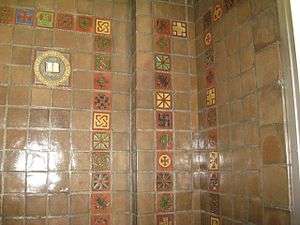
The School of Public Health-Bloomington Building (IUSPH) at Indiana University contains decorative Native American-inspired swastika tilework on the walls of the foyer and stairwells on the southeast side of the building. In response to a complaint about the tiles, "The president of the university sent a letter to the student, which explained the history of the symbol and the context in which it was placed in the School of Public Health-Bloomington (formerly HPER) building when it was built in 1917, prior to use of the symbol by the Nazis. The student appreciated the response".[148] In November 2013, a new appeal to remove the symbols appeared in the University's student paper.[149]
Swastika floor tiles appear in Breidenbaugh Hall, at Gettysburg College in Pennsylvania, built in 1927.[150]
In November 1998 the Rome, New York Sentinel newspaper reported that swastika tiles were removed from the Gansevoort Elementary School where they had survived on a school floor for 84 years. A Sentinel editorial noted that similar tiles were left untouched at a Jewish synagogue, Temple Beth El, in nearby Utica, New York "because the connotation to the Jewish congregation is not that of the Third Reich."[151]
Swastika tiles in a condominium lobby floor in White Plains, New York became the subject of a television news story and internet postings in September 2011. The housing complex's management indicated "the tile was installed before WWII when the building was built in 1924, noting it had never received a complaint before."[152]
In 1991, the Shorewood, Wisconsin school board voted to remove tiles with swastika engravings from their high School physical education building.[153]
The Reuters News Agency reported in 1990 that the seaside community of Hull, Massachusetts voted to remove swastika tiles from their town hall floor, built in 1923, after complaints from the New England Director of the Jewish Defense League.[154] The removal went forward in spite of opposition from a local Jewish synagogue.[155]
Multicolored swastika tiles are visible on the exterior of a Chinese restaurant at the Country Club Plaza in Kansas City Missouri. The building dates to the early 1930s. The editor of a local Jewish publication reacted by saying "You know, the swastika does predate Nazism. Short of any Nazi context, I don’t think you should find it offensive."[156]
The foyer of Central High School in Pueblo, Colorado features right-facing swastikas set into the tile floor. The school was built in 1906 and was added to the National Register of Historic Places in 1979.
The Bonneville County courthouse in Idaho has swastika floor tiles that have been alternately covered up and painted over. An architectural historian for the Idaho State Historical Society noted that the symbols could be removed even though the courthouse is listed on the National Register of Historic Places. In September 2009, court officials decided to leave the tiles in place.[157]
The San Mateo County History Museum, a "regional history center" in Redwood City, California is housed in the former county courthouse, built in 1910 and designed "to look as impressive as San Francisco City Hall.". The mosaic tile floor in the rotunda includes swastika designs.[158] The building is listed on the National Register of Historic Places and the museum is accredited by the American Alliance of Museums.
The A.K. Smiley Public Library in Redlands, California, built in 1894, includes a swastika tile floor design. The building has been listed on the National Register of Historic Places since 1976, and a California State Historic Landmark in 1990.[159]
Swastika tiles are visible at the San Diego Mission Beach Plunge swimming pool, which opened in 1925.
The Ernst Cafe in the New Orleans Warehouse district has a 1902 swastika pattern tile floor, with left facing symbols. The restaurant's web page notes that Hitler was a teenager when the floor was installed.[160]
The Moorish style Majestic Theater in East St. Louis, Illinois, built in 1928, features hundreds of colored tiles with a variety of geometric designs including numerous swastikas with arms pointing to the right. The theater was added to the National Register of Historic Places in 1985 but has fallen into disrepair.[161][162][163]
The Plays and Players Theatre, built in 1912 in Philadelphia, Pennsylvania, has colored swastika floor tiles. The theater was added to the National Register of Historic Places in 1973.[164]
The 116th Street–Columbia University station of the New York City Subway featured a ceramic mosaic design with a border of swastikas, which dates back to the station's 1904 opening.[165]
In early 2016, the board of directors of the Longview Community Church in Longview, Washington debated removing swastika tiles from the church, constructed in 1925,[166] and added to the National Register of Historic Places in 1985.
Miscellaneous use
.jpg)
- The 44-foot luxury yacht Lady Isabel is the centerpiece of the Wisconsin-Built Boat Gallery at the Wisconsin Maritime Museum in Manitowoc. Built in 1907, it was known for decades as the "Swastika", meaning "Well Being".[167] Swastika symbols are visible on the front of a building in the historic area of Manitowoc, built in 1894 that originally served as a hardware store.[168]
- The "Swastika Series" is a name given to a soil type in New Mexico by the U.S. National Coperative Soil Survey.[169]
- In December 2007, the Minneapolis Institute of Arts displayed a period room decorated for Christmas that included candlesticks with swastika motifs. The room's interior design had been preserved since 1905 and was created by a Minneapolis decorator. "The symbols as seen in the Duluth Room have no Third Reich connotations, but rather refer to the ancient symbol."[170]
- Jewish artist Edith Altman, whose family fled Germany in the late 1930s, has produced a travelling exhibit entitled "Reclaiming the Symbol" that "strives to reclaim the star, the cross and the swastika to their positive use.".[171][172] The exhibit features excerpts from the book "Swastika the Earliest Known Symbol and its Migrations" written by Thomas Wilson and published by the Smithsonian.
- The Smithsonian's National Air and Space Museum in Washington D.C. displays the original propeller spinner from Charles Lindbergh's aeroplane Spirit of St. Louis, manufactured in early 1927. A swastika, leftpointing, was painted on the inside of the spinner cone along with the names of all the Ryan Aircraft Co. employees that built the aeroplane, presumably as a message of good luck prior to Lindbergh's solo Atlantic crossing.[173]
- University faculty at Catholic Jesuit St. Louis University voted to remove a painting by Italian priest Renato Laffranchi in 2004. The painting symbolised four rivers flowing from the Garden of Eden, with gardens in four quadrants, and resembled a swastika with shortened arms. The university's president refused to remove the painting prior to its scheduled annual rotation.[174]
See also
- Om
- Bön
- Borjgali
- Brigid's cross
- Camunian rose
- Fascist symbolism
- Lauburu
- Sun cross
- Swastika curve
- Triskelion
- Valknut
References
- ↑ "How the world loved the swastika - until Hitler stole it - BBC News".
- ↑ Schliemann, H, Troy and its remains, London: Murray, 1875, pp. 102, 119–20
- ↑ Boxer, Sarah (2000-06-29). "One of the World's Great Symbols Strives for a Comeback". Think Tank. The New York Times. Retrieved 2012-05-07.
- ↑ Wilson, Thomas "Swastika the Earliest Known Symbol and its Migrations"
- ↑ IRM. "Australia: Dymocks Building - Pro-Swastika".
- ↑ TimeOutSydney.com.au, "Why does Customs House have Nazi swastikas on the floor?", 26 December 2007 – 22 January 2008.
- ↑ House of Commons Hansard Debates for 12 June 1996 (pt 41). Image
- ↑ "Swastikas in Scouting".
- ↑ Benjamin Joffe-Walt,"The unfortunate Bolton swastika", Guardian Unlimited, 27 April 2006.
- ↑ Martin J Powell. "Megalithic Sites in England - Photo Archive". Aenigmatis.com. Retrieved 2012-03-14.
- ↑ "Balmoral Castle War Memorial". Roll-of-honour.com. Retrieved 2012-10-09.
- ↑ "Freemasonry and 666, the Number of the Beast". Itwasjohnson.impiousdigest.com. Retrieved 2012-03-14.
- ↑ Detailed in the 2004 documentary 'The Occult History of the Third Reich'
- ↑ Department of the Official Report (Hansard), House of Commons, Westminster. "House of Commons Hansard Debates for 12 Jun 1996 (pt 41)". Parliament.the-stationery-office.co.uk. Retrieved 2012-03-14.
- ↑ here, RAF Details. "RAF - Page not found".
- ↑ Laurence Cawley, "Walls, floors and rocks: England and its swastikas", BBC News, March3, 2014
- ↑ "The Swastika In The British Isles | Home". The Fylfot File. Retrieved 2012-03-14.
- ↑ NAMShropshire (2011-08-02). "Nikarev Leshy: Odinism and the Importance of the Fylfot (Swastika)". Nikarevleshy.blogspot.com. Retrieved 2012-03-14.
- ↑ "Swastika 100th Anniversary".
- ↑ Tony Brown, "The Swastika on Canadian and Newfoundland Stamps", March 2003.
- ↑ Calgary Herald issues, 1914–1922
- ↑ "Flickr Album; "Probably the Best Photo's of Swastikas in the World"". Fiveprime.org. Retrieved 2011-05-01.
- ↑ Carlsberg Group Website Archived 29 December 2010 at the Wayback Machine.
- ↑ Finnish Airforce FAQ referenced on 17 November 2006.
- ↑ "Puolustusvoimat: Ruotuväki -uutislehti" (in Finnish). Mil.fi. Retrieved 2012-10-09.
- 1 2 Kunniakas hakaristimme Virtualpilots.fi (Finnish) Referenced on 17 November 2006.
- ↑ "Symbol on Eimskip building covered". m.travelpn.com
- 1 2 "Electric/Battery Powered Vehicles (a vehicle made up to look like such a van, for the purposes of a television drama)". Ask About Ireland. Retrieved 13 November 2009.
- ↑ "Dublin City Development Plan 2005–2011: Volume 3 – The Record of Protected Structures" (PDF). Dublin City Council. 14 March 2005. Retrieved 13 November 2009.
- ↑ "Irish Journal" translated by Leila Vennewitz (Abacus, London, 1983) pp.21–2
- ↑ Dov Gutterman, Latvia: Aircraft Marking, 20 June 2004.
- ↑ Laura Sheeter "No swastikas" for Nato mittens BBC News
- ↑ Kjell Tjensvoll Flickr Image
- ↑ "Z uroczystości odsłonięcia pomnika Mieczysława Karłowicza - Górale i Tatry na starych fotografiach".
- ↑ "World Banknotes, Russia". Atsnotes.com. 2012-09-17. Retrieved 2012-10-09.
- ↑ Maps, arizonaroads.com, accessed 5 June 2011.
- ↑ Merit Network Inc Website Archived 15 July 2007 at the Wayback Machine.
- ↑ "From Swastika to Thunderbird". 45th Infantry Division Museum.
- ↑ Brigadier General Ross. H. Routh (Ret.) "From Swastika to Thunderbird". The M38A1 Restoration Site. History of the 45th Infantry Division
- ↑ Gaylord College of Journalism and Mass Communication, 'Routes' online magazine, "Oklahoma's Thunderbirds wear historic emblem"
- ↑ http://www.wwiaviation.com "Escadrille Americaine"
- ↑ See photo: "an American plane decorated with a swastika and Indian chief head, symbol of the escadrille" "Flying for France" Hero Tales of Battles in the Air, Told by James R. McConnell, Sergeant-Pilot in the French Flying Corps, With the American Escadrille at Verdun.
- ↑ New Hanover County Public Library, "Wilmington in pictures" Louis T. Moore Collection, Photograph Number 35, Oakdale Cemetery – Hebrew Cemetery – Grave of Arthur Bluethenthal.
- ↑ National Park Service, "Cultural Resources, Links to the Past", US Post Office, Reno Main
- ↑ Frank Whelan, "Post office tiles symbolize sun", The Morning Call, December 29, 2004
- ↑ See photo Old Courthouse Grate
- ↑ "National Register of Historical Places - NEW MEXICO (NM), Bernalillo County".
- ↑ Eugene A. Toepel, County Judge, "A History of What Was the third Court House in La Crosse, Wisconsin 1903–65", 11 November 1965, printed by La Crosse Public Library.
- ↑ Andrew Jarosh, "Restoration of rotunda murals recaptures their strange beauty and grandeur.", The News-Sentinel, 2007.
- ↑ Allen County Indiana, Courthouse Preservation Trust website, 2005.
- ↑ Brad Bauer,"First county courthouse built in 1798", Marietta Times, 5 January 2008.
- ↑ Laguna Bridge
- ↑ Darin Fenger, "Symbol of luck, swastika adorn Yuma dam", Yuma Sun newspaper, Yuma, Arizona, 25 September 2005.
- ↑ Walter Smoter Frank, "Swastika on the Colorado", 2004
- ↑ Sandra Swanson, Chicagomag.com, "The Annotated: Baha'i Temple"
- ↑ New York Architecture Images – Gramercy park, Transfiguration (Episcopal) – aka "The Little Church Around The Corner" Top Ten New York Churches.
- ↑ Michigan Council for Arts and Cultural Affairs,Michigan Stained Glass Census website.
- ↑ Yerkes Observatory Virtual Tour, see plaster owl at bottom of page.
- ↑ "Swastika Park Irks Residents Miami Community was Named in 1917", Associated Press, 20 April 1992, Page 7F, San Jose (Ca) Mercury News.
- ↑ "Swastika Acres Predates Nazism, But Still Offensive", Cincinnati Post (Cincinnati, Ohio), 4 December 1997.
- ↑ "Historic Auto Trails, Iowa Non-Registered Routes"
- ↑ Bill Strong, flickr photograph, 1913 Krit 5-passenger touring car with swastika radiator badge.
- ↑ United Valve, Valve History website.
- ↑ Buffum Tool Company, Pike County Genealogical Society website.
- ↑ "BUFFUM TOOL CO. HISTORY", The Winchester * Keen Kutter * Diamond Edge Chronicles, Hardware Companies Kollectors Klub.
- ↑ Picture of "laundry tray" bearing Washington Charcrete Co logo, Wikipedia
- ↑ Rubbing of Washington Charcrete Co logo featuring a swastika taken from a "laundry tray", Wikipedia
- ↑ "The Pacific Reporter". West Publishing Company. 1 January 1913 – via Google Books.
- ↑ Scripopyily.com "Duplex Adding Machine Company 1910 – Swastika Logo.
- ↑ Souvenir History of St. Dominic's Church 1822–1909, page 34.
- ↑ Quipu, A Newsletter Published By The New Mexico State Records Center and Archives, Santa Fe, New Mexico, Vol. 9.1, April 2004, page 2.
- ↑ The Spokesman-Review, "Swastika Beat Neo-Nazis to NIdaho", Sept 4, 2009.
- ↑ Bob Hyman, "The Other Cimarron", http://members.cox.net
- ↑ "Sausalito Historic District Buildings and Sites" Sausalito, California Historical Society.
- ↑ Indiana Division of Historic Preservation and Archeology, theatre survey.
- ↑ [[email protected] Elijah J. Bond biography]
- ↑ Multi-Wood Surfboards, Pacitic System Homes Surfboard, from WoodSurfboards.com Surf History Preservation Collection.
- ↑ Malcolm Gault-Williams, "Legendary Surfers, A Definitive History of Surfing's Culture and Heroes, John Heath "Doc" Ball", October 2004.
- ↑ Bill Iddings, The Muskegon Chronicle, Oct 10, 2011 "Extra Iddings: A cow steals the show. What's with the swastikas?"
- ↑ Robert Kenneth Jones, The Shudder Pulps: A History of the Weird Menace Magazines of the 1930s. Plume. (p. 78) ISBN 0-452-25190-7.
- ↑ Nevada Department of Cultural Affairs, Swastika quilt
- ↑ Monte Whaley, "Swastika quilt donated to Greeley Museums is quirk of history," Denver Post, 28 June 2010.
- ↑ Tim Leeds, "Swastika-like display causes controversy. Symbol on 1920s quilt misinterpreted", Havre Daily news, 11 January 2011.
- ↑ Steven Heller, Jeff Roth, The Swastika, Symbol Beyond Redemption?, Allworth Press, 2000, page 87.
- ↑ The New York Times, 16 September 1937, quoted in Heller, page 80
- ↑ "Vintage KidStuff Online Museum". Summerpearl.com. Retrieved 2012-10-09.
- ↑ Walter M. Kimbrough, Black Greek 101: The Culture, Customs and Challenges of Black Fraternities, August 2003.
- ↑ Catawba College website, "About the Sayakini" (yearbook)
- ↑ Tom Schieber, Baseball Researcher, "Rabbit Maranville Is Not a Nazi", February 19, 2010.
- ↑ Iowa Women's Archives, University of Iowa Libraries, "Freedom Township Women's Club"
- ↑ Missouri University of Science and Technology, Western Historical Manuscript Collection, 1921 Pamphlet.
- ↑ "Eastern Canoe Races", New York Times, 11 July 1915.
- ↑ "Pawtuxet Village Historic Homes & Buildings", September 2007.
- ↑ Gary Patterson, "United States Swastika 1907–1936"
- ↑ Brenda Kruse, "A surprising symbol in John Deere's past", Sept 25, 2000.
- ↑ Frederick Lieder political button collection, Harvard University, Cambridge, MA, website 2003.
- ↑
- ↑ Daniel M. West, "So-Called Dollars: H&K-895 WWI Good Luck Medal", Willamette Coin Club website, Portland Oregon
- ↑ Craig Murray, "Good Luck Scout Tokens"
- ↑ "Forgotten New York" website, "COMMIES AND FASCISTS. Their governments may be dead, but some of the remains can be found in NYC"
- ↑ Cleveland State University, The Cleveland Memory Project, Garfield Monument at the Lake View Cemetery.
- ↑ Sandy Mitchel, The Garfield Monument Lakeview Cemetery, About.com
- ↑ Emporis.com James A. Garfield Memorial
- ↑ Flickr, posted by 'floeverstate', Sterling Memorial Library, "Main facade, Left Entryway"
- ↑ Chuck Goudie, Ann Pistone, "Swastikas on public buildings, homes in Chicago", ABC7 I-Team Investigation, July 13, 2015.
- ↑ Patty Dean, "Unique and Handsome: Cass Gilbert's Designs for the Montana Club", Drumlummon Views, Spring/Summer 2006, page 11.
- ↑ "Discover Helena, Treasure of the Treasure State", Helena Convention and Visitors Bureau website.
- ↑ Albuquerque, New Mexico, Official City Website, "swastikas"
- ↑ "1914 Corn Palace..notice the swastika on the fron… Photo - Mitchell".
- ↑ Weston photo and comments on flickr.com
- ↑ "Mountainair".
- ↑ Philadelphia Museum of Art, ["Perelman Building : Building History" http://www.philamuseum.org/information/45-289-292-103.html]
- ↑ Walton, Krista. "Philadelphia Museum of Art Expands into 1927 Office Building". Preservation Online. Retrieved 2007-08-05.
- ↑ Servando Gonzalez, "The swastika and the Nazis"
- ↑ Margie Fishman "A bad sign at Glenside Fire Station? A swastika has upset some residents. But supporters note the symbol's honorable pre-Nazi history." Philadelphia Inquirer, May 28, 2001.
- ↑ Augustan Society, Inc. News Page, 28 October 2002.
- ↑ Acclaim Images, "Posters and Art Prints – Poster Print of Ornate Facade With Swastika on the Alexander & Baldwin Building"
- ↑ "CuriosiD: Why Are There Swastikas in Parts of Indian Village? Dec. 17, 2015"
- ↑ "Architecture & Symbolism - The First Chinese Church of Christ in Hawaii".
- ↑ Houston, an architectural guide, Houston Chapter AImerican Institute of Architects
- ↑ Scott H. Howard, City Attorney, Glendale, California City of Glendale Interdepartmental Communication, 17 August 1995.
- ↑ JewishJournal.com "Glendale Discusses Future of Swastika Lampposts", 11 October 2002.
- ↑ Katie Baker, "Ask the Appeal: Why Are There Swastikas On SF’s Old Mint?", The San Francisco Appeal, December 3, 2010
- ↑ "Quarterly Meeting of the STATE HISTORICAL RESOURCES COMMISSION", 9 May 2003, page 6.
- ↑ Columbus Ledger-Enquirer (GA), "Fight Promised For Removal of Swastikas", 15 January 1999.
- ↑ Donald H. Harrison, "Symbol problems: cross and swastika spark city controversies", Jewish Sightseeing, 26 June 1998.
- ↑ "Richard Amero, History of the House of Hospitality Building in Balboa Park". Sandiegohistory.org. Retrieved 2012-10-09.
- ↑ Panama-California Exposition, Chapter 4: East Meets West in Balboa Park.
- ↑ Lyn Topinka, "The Columbia River - A Photographic Journey", "Lewis & Clark's Columbia River - "200 Years later"","Jantzen Beach Carousel, Portland Oregon". See section on wooden horse named "Hector..."
- ↑ Lyn Topinka, "Jantzen Beach Carousel, Portland, Oregon", see section on "Hector", the carousel horse with swastika saddle, from "The Columbia River, A Photographic Journey", English River Website, October 2006.
- ↑ John Brand, "Swastika tiles in Statehouse symbolize luck, not genocide", Press of Atlantic City website pressofatlancitcity.com, 2 October 2005.
- ↑ Rebecca Golden Nov 11, 2015 Detroit "Columnist to Detroit Athletic Club: Remove the Swastikas"
- ↑ The sixth-grade students of CityLife Downtown Charter School Los Angeles, "The Sacred Spaces of Wilshire Boulevard, A Guide for Kids, by Kids" Copyright 2005, CityLife Downtown Charter School and the Los Angeles Conservancy.
- ↑ Dave Schwarz photograph, St. Cloud Times photo gallery, 3 May 2006, showing removal of 1920s era terra cotta swastika tile.
- ↑ History of Saint Mary's Cathedral, Cathedral of St. Mary, St. Cloud, Minnesota website, author not identified, "History of the Luminous Disks", 9 July 2006.
- ↑ Swastika – The Symbol of the Buddha (website) The Baskian Swastika Lauburu, its symbolic meaning and history
- ↑ Ann M. Harrington and Prudence Moylan, Mundelein Voices, page 32.
- ↑ Robert Lavenda, "A History of Swastikas", Insights For A Diverse Campus Community, St. Cloud State University, Volume II, Issue 4, Spring 2005, page 3 .
- ↑ Midlands Heritage Co UK photo examples, 7 August 2011
- ↑ Jay Furst, "When is a swastika not a swastika?", Rochester Post-Bulletin, 3 January 2006.
- ↑ The Ellerbe Tradition, Seventy Years of Architecture & Engineering, Thomas F. Ellerbe, 1980, page 30.
- ↑ "Plummer House History & Facts", City of Rochester, Minnesota Park and Recreation Department website.
- ↑ Duluth, MN – Swastika-Like Tiles at Congdon School Will Stay, Duluth Tribune, 20 August 2008.
- ↑ Johnstown Area Heritage Association, "Historic Cambria City Walking Tour Guide"
- ↑ Cynar, 1987, "The Architecture of St. Columba Church", "Offerings of Stone" University of Pittsburgh at Johnstown.
- ↑ "Associated Press, Toledo Blade, 23 March 1996". News.google.com. Retrieved 2012-10-09.
- ↑ Arizona Capital Times, "Hate or rolling logs? Meaning changes for symbol", 17 November 2006. Requires subscription for access.
- ↑ Office of Student Ethics and Anti-Harassment Programs, University of Indiana, report 1 July 2001 through 20 June 2002.
- ↑ Eli Goldaris, Indiana Daily Student, "Time to remove the swastikas at IU", Nov 14, 2013
- ↑ Ragno, Sergio J. A. III, "Hidden in Plain Sight: The Remnants of a Shard of Hope Tainted by the Shadow of Evil", Spring 2006.
- ↑ "Our Opinion" Editorial, "Lost Chance to Educate", Daily Sentinel, Rome, NY, 5 November 1998.
- ↑ Facebook News 12 cable television network, Long Island New York, 28 September 2011.
- ↑ Thom Hemmann,"Removal of Tiles Approved", Milwaukee Sentinel, 11 Dec 1991, page 4A.
- ↑ "Massachusetts Town Votes To Remove Indian Swastikas", Reuters, 14 January 1990.
- ↑ David Grossack, "Donkeys in Brownshirts", Tinytown Gazette Newspaper and Advertising Company, 4 October 2006, Page 10.
- ↑ Eric Barton, "No, It's Not the Plaza Nazis", The Pitch, Kansas City News Blog, 27 April 2007.
- ↑ The Associated Press, 9/3/09 "Idaho court won't remove pre-Nazi swastika tiles."
- ↑ "Watch your step", Oakland Tribune, 6 Jul 2005.
- ↑ A.K.Smiley Public Library. See also photo essay by Jennifer F., Gather website, April 2007.
- ↑ "Ernst Cafe website, 2011". Ernstcafe.net. Retrieved 2012-10-09.
- ↑ Built St. Louis, East St Louis Crumbling Landmarks, Majestic Theater
- ↑ ""The IBEX Archive" (Illinois Bottomland Explorer), East St. Louis Action Research project, "Majestic Theater"". Eslarp.uiuc.edu. Retrieved 2012-10-09.
- ↑ See also detailed photos at Cinema Treasurers website.
- ↑ Sarah M. Hyson, "A Preliminary Survey of the Historic Plays and Players Theatre: Preservation Issues to Be Addressed", University of Pennsylvania Theses (Historic Preservation), 2005. See color photograph: "Figure 11, Decorative Tile in Lobby", Page 28.
- ↑ http://www.newyorkfirst.com/gifts/7048.html
- ↑ Marissa Luck, Mar 3, 2016, The Daily News Online Longview WA, "Should Longview Community Church remove swastika floor tiles?"
- ↑ "Burger Boat Cruiser Lady Isabel has a Unique Story to Tell", Wisconsin Maritime Museum, Anchor News, Winter 2004.
- ↑ "Celebrate Historic Preservation" brochure, Herald Times Report, Lakeshore Chronicle, 18 May 2005.
- ↑ New Mexico soil survey: Swastika series page 139
- ↑ Jennifer Komar Oliverez, associate curator, Architecture, Design, Decorative Arts, Craft and Sculpture, Star Tribune 23 Dec 2007.
- ↑ Edith Altman,"Reclaiming the Symbol/The Art of Memory", Installation, 1988–1992.
- ↑ Stephen C. Feinstein, "Witness and Legacy", Center for Holocaust Genocide Studies, University of Minnesota website.
- ↑ File:Spirit of St. Louis Nose Cone 1.jpg cone, inside
- ↑ Katie Childs, "Biondi refuses to remove painting Denies student, faculty requests" The University News, St. Louis University, 15 April 2004.

